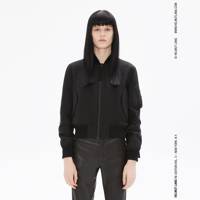To aid with the selection of items which would resonate best with a new generation of customers forming their own attachment to Helmut Lang, the brand enlisted Byronesque. Dealers from the vintage personal shopping app chose unisex clothing, including a split-hem tank, bomber jacket, printed T-shirt and Velcro bulletproof vest, all of which were originally released between 1994 and 2004.
“We started by looking at the specific requests we get in our app for vintage Helmut Lang,” Byronesque founder Gill Linton tells Vogue, upon the launch of the capsule. “But it was important to us that we made a statement with the collection, rather than put out a random selection of clothes.”
Since launching the online platform in 2013, Linton has come across many Lang fans. “They are some of the most ardent of all, even more so than Margiela followers and they’re passionately vocal about change,” she shares. “We became very aware that the time was right to celebrate Helmut himself and how he felt about culture and creativity.” Bryonesque’s research led them to the “now very relevant” quote seeded from an interview that Lang gave when he exited his namesake company in 2005: “It’s dangerous to become over-exposed.”

To continue the Helmut Lang narrative, Bryonesque created the idea of the brand “going dark” blacking out the stores and campaign imagery to let the reissued products speak for themselves. “We didn’t feel the need to add more to the current vanity-obsessed culture,” Westover asserts. “Even though Byronesque deals with vintage clothes, we behave like a contemporary brand with everything we do viewed through the lens of the culture of the time. There was always a darkness to Lang's bondage-inflected collections, which is evident in this re-edition.”
When nostalgia continues to be firmly entwined in the trend zeitgeist, Linton’s feeling that “the early 2000s was possibly the last era that fashion was really a creative business,” has filtered down to the consumer, too. “There’s a definite longing for clothes and brands that recreate that. We especially see it from younger people who weren’t part of Gang Lang the first time around.”

No comments:
Post a Comment